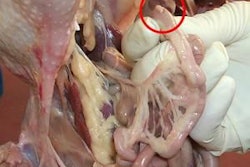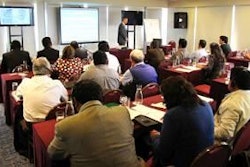When the poultry industry advanced from open drinkers and troughs to enclosed nipple lines, it was the perfect solution to both labor and contamination challenges. Yet, the test of time has proven that while enclosing the water supply in a poultry barn has greatly improved water’s sanitary qualities, it has not eliminated the risk of disease challenges.
Enclosed systems provide no visual reminder that mineral deposits and slime are a problem. Secondly, live production doesn’t have a true appreciation for the versatility of waterborne microbes given the perfect environment of a slow moving and nutrient filled water supply.
The abundance of “water additives” and affordable, easy-to-use injection technologies make it hard for producers to resist putting something in the water. Working with companies and producers through the years has provided insight into why poultry house water systems need proper cleaning as well as what constitutes the best cleaning procedure.
Natural water contaminants: An overlooked contributor
Water’s true identity comes from the substances dissolved in it such as iron, manganese, calcium, magnesium, sulfates, sodium, chloride, etc. These give water its taste and properties such as pH, hardness, staining, sediment or even corrosiveness.
While the Environmental Protection Agency (EPA) calls anything dissolved in water a contaminant, being good or bad is a factor of what, and how much, is present. While 60 mg/l or part per million (ppm) of calcium isn’t a concern, as little as 1 ppm of iron is enough to promote harmful bacteria such as Pseudomonas, E. coli and even Salmonella. And sulfur bacteria can airlock water lines, or slightly salty water can lead to Enterococcus bacteria. The potential for microorganism problems is a reality when the food supply is present.
Water additives: Good for the birds, good for the microbes
Water can effectively deliver to birds nutritional or therapeutic supplements, since the birds consume twice as much water as feed. Water’s popularity as the delivery system is confirmed by the list of products frequently used including vitamins, electrolytes, vaccines and vaccine stabilizers, mineral cocktails, acids, prebiotics, probiotics and antibiotics. While these can be vital in production, they can also impact the cleanliness of water systems.
- Water additives providing nutrients or quick energy sources do the same for microbes.
- Water acidification is good for the birds, but also good for many microbes, particularly if the pH doesn’t drop below 4.
- Milk replacers neutralize chlorine and enhance vaccines, but a whole host of water life can harvest, store and thrive on milk nutrients.
- Antiobiotics help birds recover from certain bacteria, but yeasts, molds and fungus can bloom during water antibiotic treatment.
If an additive benefits the birds, there is some watery life form that will find it beneficial.
Proving the challenge exists
It is human nature to want proof microbial challenges exist in water lines before taking corrective action. For many years pulling a water sample from the end of the line was believed to give all the information necessary as to the microbial condition of a drinking water system. The aerobic plate counts (APC) observed in water samples from four farms provides are an excellent example of the benefits of water testing (Table 1) for identifying challenges.
Recent evaluations reveal that evaluating the microbial condition of a water system requires more than a water sample from the line. End-of-the-line drip samples with 2 and 4 cfu/ml of APC were compared to sterile swabs inserted into the water lines (90,000 and 270,000 cfu/ml APC) and the results revealed that a biofilm was indeed present (Figure 1). Relying on the drip sample results would have been misleading. Swabbing is a better indicator of the microbial integrity of the water system.
What is the best method for line cleaning?
Once the need for line cleaning is confirmed, either through testing or reviewing the history of the system, the next step is to pick the best method and clean the entire system. Acidifiers that do not lower the pH to below 4 and bleach in just about any concentration including up to 3% are not good choices. Concentrated, stabilized, hydrogen peroxide products used at the manufacturers’ recommendations are some of the most effective cleaners without harming the equipment. Before using any product, confirm with the manufacturer or supplier that it is safe to use with your equipment.
As important as choosing the right product is the right concentration. Products like ProxyClean and HydroLine Cleaner are no miracle workers if the concentration is not adequate. Our lab tests using thick algae water showed that 1% concentrations (similar concentration achieved injecting straight product with a 1:128 injector or medicator) left significant microbial challenge still alive (Table 2). It took the 3 % concentrations of these products to eliminate all growth.
Most product recommendations are for a 2% to 3% solution, so it may be necessary to mix the solution into a barrel or small stock tank and then pump into the water system with a transfer pump connected directly to the line or through the medicator connection. There are now available injectors such as the Quick Mix that can be hooked up like a medicator and will inject the proper dilution straight from the product concentrate.
Bottom line: the appropriate concentration is important for success.
Is line cleaning always successful?
Cleaning the entire system seems to be the one point that is the most overlooked. It is critical to clean as much of the water system as possible for optimum success and this includes the standpipes, the nipple drinkers and as much of the distribution system as possible including underground lines running from the well house to the barns.
One turkey producer did a great job of cleaning the main water line in his grow-out barn but did not clean the water hoses to each Plasson drinker. Swabs of the main line showed the system was fairly clean with less than 5,000 cfu/ml of aerobic bacteria after line cleaning, but when the uncleaned drinker hoses were examined the counts soared to over 300,000 cfu/ml. Leaving critical parts of the drinking system contaminated will undo all the good cleaning can do.
The last thing to remember about line cleaning is that even the best products available used at the ideal rates may still not be enough particularly if the system has a strong biofilm. Monitoring was done to check the line cleaning success on one farm which actually had a very good daily water sanitation program but line cleaning had not been done in several flocks.
As Table 3 shows, microbial activity remained in the system after a 48-hour line cleaning with Proxyclean and a 24-hour line cleaning with CID Cleaner (Table 4). Does this mean the products are not useful? Absolutely not! This test just demonstrates how utterly resilient biofilms are and how diligence with an effective daily water sanitation program plus repeated line cleaning between flocks may be the only cure for a problem entrenched in the water system.
Water sanitation is a key to good performance
The evidence is growing that water sanitation can be a crucial tool in addressing poor performance. The industry is beginning to understand though just how tough biofilms really are and that if production is to win the battle against water system borne problems, we need the right tools used in the correct manner.
- The first step towards achieving success with water sanitation is identifying the factors which could be contributing to poor water quality such as natural contaminants, lack of a daily water sanitation program as well as use of different types of water additives.
- The second step is to clean the water system with products which have a proven track record of success at the levels recommended by the manufacturers.
- Lastly, it is important to remain committed to line cleaning and a good daily water sanitation program because the world of water organisms is complex and resilient. The challenge won’t go away without a strong plan of attack.

















